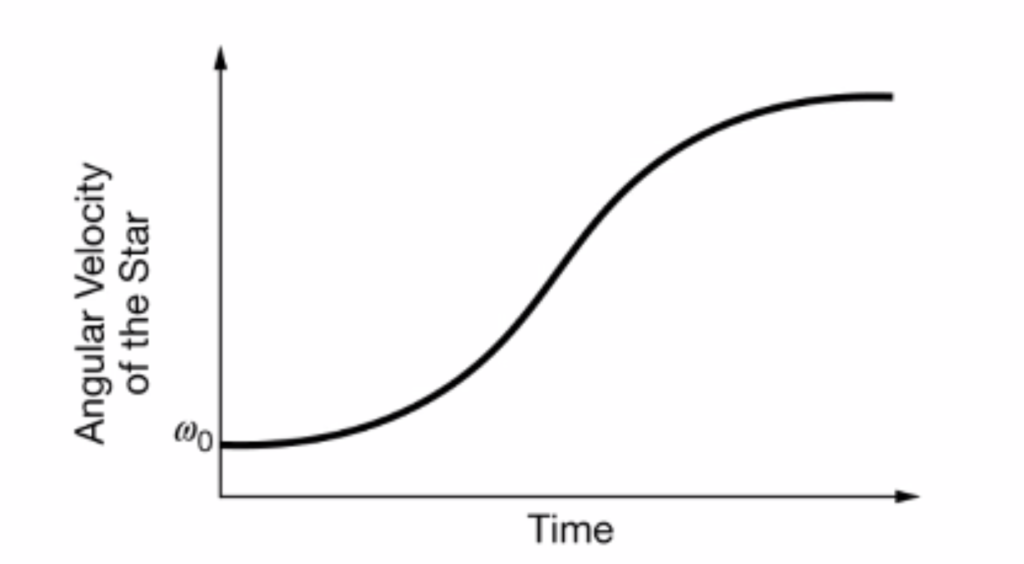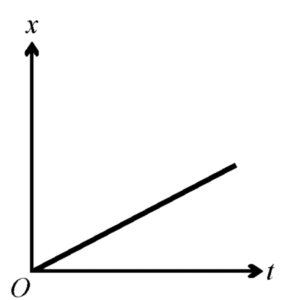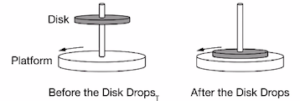0 attempts
0% avg
UBQ Credits
| Derivation/Formula | Reasoning |
|---|---|
| \[ \omega(0) = \omega_0 \] | At \( t=0 \) the disk spins counterclockwise, so \( \omega(0)=\omega_0>0 \) with CCW taken as positive. |
| \[ \tau = FR \] | A tangential force \( F \) applied at radius \( R \) produces torque magnitude \( \tau=FR \); the sign follows the CCW-positive convention. |
| \[ \tau_L = (+20)R \] | The left downward force at \( x=-R \) makes a CCW torque, so \( \tau_L=+20R \). |
| \[ \tau_R = (-40)R \] | The right downward force at \( x=+R \) makes a CW torque, so \( \tau_R=-40R \). |
| \[ \tau_{\text{net}} = \tau_L + \tau_R = (20-40)R = -20R \] | Net torque is CW because \( 40>20 \); hence \( \tau_{\text{net}}<0 \). |
| \[ \alpha = \frac{\tau_{\text{net}}}{I} \] | With constant torques, angular acceleration \( \alpha \) is constant. Since \( I>0 \) and \( \tau_{\text{net}}<0 \), we get \( \alpha<0 \). |
| \[ \omega(t) = \omega_0 + \alpha t \] | For constant \( \alpha \), \( \omega(t) \) is a straight line with slope \( \alpha<0 \), starting at \( \omega_0 \). |
| \[ t_{\text{zero}} = \frac{\omega_0}{|\alpha|} \] | \( \omega(t) \) crosses zero at \( t=\omega_0/|\alpha| \) and becomes negative afterward, indicating reversal to CW. |
| \[ \text{Select (c)} \] | The correct graph must start at \( \omega_0 \) and decrease linearly past zero; this matches option \( \text{(c)} \). |
| Derivation/Formula | Reasoning |
|---|---|
| \[ \text{(a)}:\ \omega(0)=-\omega_0,\ \alpha>0 \] | Starts negative and increases; contradicts \( \omega(0)=\omega_0>0 \) and our \( \alpha<0 \). |
| \[ \text{(b)}:\ \alpha=0 \] | Constant \( \omega \) requires \( \tau_{\text{net}}=0 \), but here \( \tau_{\text{net}}=-20R\ne0 \). |
| \[ \text{(c)}:\ \omega(0)=\omega_0,\ \alpha<0 \] | Decreasing straight line crossing zero, exactly what a constant negative \( \alpha \) produces. Correct. |
| \[ \text{(d)}:\ \text{sign}(\alpha): – \to + \] | V-shape implies \( \alpha \) reverses sign after some time, which would require a changing net torque; our \( \tau_{\text{net}} \) is constant. |
Just ask: "Help me solve this problem."
A uniform, solid, \( 100 \) \( \text{kg} \) cylinder with a diameter of \( 1.0 \) \( \text{m} \) is mounted so it is free to rotate about a fixed, horizontal, frictionless axis that passes through the centers of its circular ends. A \( 10 \) \( \text{kg} \) block is hung from a very light, thin cord wrapped around the cylinder’s circumference. When the block is released, the cord unwinds and the block accelerates downward. What is the acceleration of the block?

What is the net torque acting on the pivot supporting a \(10 \, \text{kilogram}\) beam \(2 \, \text{meters}\) long as shown above? Assume that the positive direction is clockwise.

An isolated spherical star of radius [katex] R_o [/katex], rotates about an axis that passes through its center with an angular velocity of [katex] \omega_o [/katex]. Gravitational forces within the star cause the star’s radius to collapse and decrease to a value [katex] r_o <R_o [/katex], but the mass of the star remains constant. A graph of the star’s angular velocity as a function of time as it collapses is shown. Which of the following predictions is correct about the angular momentum [katex] L [/katex] of the star immediately after the collapse?
 The displacement \(x\) of an object moving in one dimension is shown above as a function of time \(t\). The velocity of this object must be
The displacement \(x\) of an object moving in one dimension is shown above as a function of time \(t\). The velocity of this object must be

A platform is initially rotating on smooth ice with negligible friction, as shown above. A stationary disk is dropped directly onto the center of the platform. A short time later, the disk and platform rotate together at the same angular velocity, as shown at right in the figure. How does the angular momentum of only the platform change, if at all, after the disk drops? And what is the best justification.
By continuing you (1) agree to our Terms of Use and Terms of Sale and (2) consent to sharing your IP and browser information used by this site’s security protocols as outlined in our Privacy Policy.
| Kinematics | Forces |
|---|---|
| \(\Delta x = v_i t + \frac{1}{2} at^2\) | \(F = ma\) |
| \(v = v_i + at\) | \(F_g = \frac{G m_1 m_2}{r^2}\) |
| \(v^2 = v_i^2 + 2a \Delta x\) | \(f = \mu N\) |
| \(\Delta x = \frac{v_i + v}{2} t\) | \(F_s =-kx\) |
| \(v^2 = v_f^2 \,-\, 2a \Delta x\) |
| Circular Motion | Energy |
|---|---|
| \(F_c = \frac{mv^2}{r}\) | \(KE = \frac{1}{2} mv^2\) |
| \(a_c = \frac{v^2}{r}\) | \(PE = mgh\) |
| \(T = 2\pi \sqrt{\frac{r}{g}}\) | \(KE_i + PE_i = KE_f + PE_f\) |
| \(W = Fd \cos\theta\) |
| Momentum | Torque and Rotations |
|---|---|
| \(p = mv\) | \(\tau = r \cdot F \cdot \sin(\theta)\) |
| \(J = \Delta p\) | \(I = \sum mr^2\) |
| \(p_i = p_f\) | \(L = I \cdot \omega\) |
| Simple Harmonic Motion | Fluids |
|---|---|
| \(F = -kx\) | \(P = \frac{F}{A}\) |
| \(T = 2\pi \sqrt{\frac{l}{g}}\) | \(P_{\text{total}} = P_{\text{atm}} + \rho gh\) |
| \(T = 2\pi \sqrt{\frac{m}{k}}\) | \(Q = Av\) |
| \(x(t) = A \cos(\omega t + \phi)\) | \(F_b = \rho V g\) |
| \(a = -\omega^2 x\) | \(A_1v_1 = A_2v_2\) |
| Constant | Description |
|---|---|
| [katex]g[/katex] | Acceleration due to gravity, typically [katex]9.8 , \text{m/s}^2[/katex] on Earth’s surface |
| [katex]G[/katex] | Universal Gravitational Constant, [katex]6.674 \times 10^{-11} , \text{N} \cdot \text{m}^2/\text{kg}^2[/katex] |
| [katex]\mu_k[/katex] and [katex]\mu_s[/katex] | Coefficients of kinetic ([katex]\mu_k[/katex]) and static ([katex]\mu_s[/katex]) friction, dimensionless. Static friction ([katex]\mu_s[/katex]) is usually greater than kinetic friction ([katex]\mu_k[/katex]) as it resists the start of motion. |
| [katex]k[/katex] | Spring constant, in [katex]\text{N/m}[/katex] |
| [katex] M_E = 5.972 \times 10^{24} , \text{kg} [/katex] | Mass of the Earth |
| [katex] M_M = 7.348 \times 10^{22} , \text{kg} [/katex] | Mass of the Moon |
| [katex] M_M = 1.989 \times 10^{30} , \text{kg} [/katex] | Mass of the Sun |
| Variable | SI Unit |
|---|---|
| [katex]s[/katex] (Displacement) | [katex]\text{meters (m)}[/katex] |
| [katex]v[/katex] (Velocity) | [katex]\text{meters per second (m/s)}[/katex] |
| [katex]a[/katex] (Acceleration) | [katex]\text{meters per second squared (m/s}^2\text{)}[/katex] |
| [katex]t[/katex] (Time) | [katex]\text{seconds (s)}[/katex] |
| [katex]m[/katex] (Mass) | [katex]\text{kilograms (kg)}[/katex] |
| Variable | Derived SI Unit |
|---|---|
| [katex]F[/katex] (Force) | [katex]\text{newtons (N)}[/katex] |
| [katex]E[/katex], [katex]PE[/katex], [katex]KE[/katex] (Energy, Potential Energy, Kinetic Energy) | [katex]\text{joules (J)}[/katex] |
| [katex]P[/katex] (Power) | [katex]\text{watts (W)}[/katex] |
| [katex]p[/katex] (Momentum) | [katex]\text{kilogram meters per second (kgm/s)}[/katex] |
| [katex]\omega[/katex] (Angular Velocity) | [katex]\text{radians per second (rad/s)}[/katex] |
| [katex]\tau[/katex] (Torque) | [katex]\text{newton meters (Nm)}[/katex] |
| [katex]I[/katex] (Moment of Inertia) | [katex]\text{kilogram meter squared (kgm}^2\text{)}[/katex] |
| [katex]f[/katex] (Frequency) | [katex]\text{hertz (Hz)}[/katex] |
General Metric Conversion Chart
Example of using unit analysis: Convert 5 kilometers to millimeters.
Start with the given measurement: [katex]\text{5 km}[/katex]
Use the conversion factors for kilometers to meters and meters to millimeters: [katex]\text{5 km} \times \frac{10^3 \, \text{m}}{1 \, \text{km}} \times \frac{10^3 \, \text{mm}}{1 \, \text{m}}[/katex]
Perform the multiplication: [katex]\text{5 km} \times \frac{10^3 \, \text{m}}{1 \, \text{km}} \times \frac{10^3 \, \text{mm}}{1 \, \text{m}} = 5 \times 10^3 \times 10^3 \, \text{mm}[/katex]
Simplify to get the final answer: [katex]\boxed{5 \times 10^6 \, \text{mm}}[/katex]
Prefix | Symbol | Power of Ten | Equivalent |
|---|---|---|---|
Pico- | p | [katex]10^{-12}[/katex] | 0.000000000001 |
Nano- | n | [katex]10^{-9}[/katex] | 0.000000001 |
Micro- | µ | [katex]10^{-6}[/katex] | 0.000001 |
Milli- | m | [katex]10^{-3}[/katex] | 0.001 |
Centi- | c | [katex]10^{-2}[/katex] | 0.01 |
Deci- | d | [katex]10^{-1}[/katex] | 0.1 |
(Base unit) | – | [katex]10^{0}[/katex] | 1 |
Deca- or Deka- | da | [katex]10^{1}[/katex] | 10 |
Hecto- | h | [katex]10^{2}[/katex] | 100 |
Kilo- | k | [katex]10^{3}[/katex] | 1,000 |
Mega- | M | [katex]10^{6}[/katex] | 1,000,000 |
Giga- | G | [katex]10^{9}[/katex] | 1,000,000,000 |
Tera- | T | [katex]10^{12}[/katex] | 1,000,000,000,000 |
The most advanced version of Phy. 50% off, for early supporters. Prices increase soon.
per month
Billed Monthly. Cancel Anytime.
Trial –> Phy Pro
We crafted the ultimate A.P Physics 1 course that simplifies everything so you can learn faster and score higher.
Try our free calculator to see what you need to get a 5 on the upcoming AP Physics 1 exam.
A quick explanation
Credits are used to grade your FRQs and GQs. Pro users get unlimited credits.
Submitting counts as 1 attempt.
Viewing answers or explanations count as a failed attempts.
Phy gives partial credit if needed
MCQs and GQs are are 1 point each. FRQs will state points for each part.
Phy customizes problem explanations based on what you struggle with. Just hit the explanation button to see.
Understand you mistakes quicker.

Phy automatically provides feedback so you can improve your responses.
10 Free Credits To Get You Started

By continuing you agree to nerd-notes.com Terms of Service, Privacy Policy, and our usage of user data.
NEW! PHY AI accurately solves all questions
🔥 Get up to 30% off Elite Physics Tutoring
🧠 NEW! Learn Physics From Scratch Self Paced Course
🎯 Need exam style practice questions?